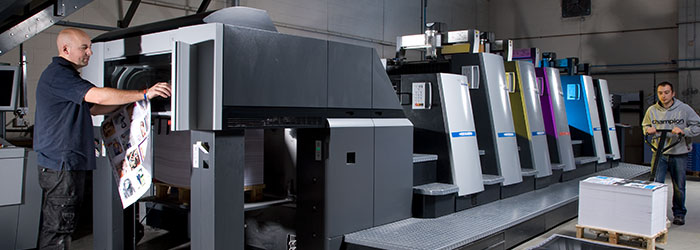How litho printing Delivers Sharp and Bold Prints
How litho printing Delivers Sharp and Bold Prints
Blog Article
A Comprehensive Overview to Recognizing Litho Printing Methods
The globe of litho printing, a strategy stemming from the late 18th century, is an interesting mix of background, development, art and science. This thorough guide will unravel the intricacies of this printing method, from the structure of litho inks to the obstacles dealt with in modern-day applications. As we venture right into the ins and outs of lithography, the relevance of automation and sustainability in guaranteeing its future importance ends up being significantly clear. Keep with us as we journey into the fascinating world of litho printing.
The Historic Development of Litho Printing
The historical trajectory of litho printing, an essential advancement in the realm of communication, is a captivating tale of human resourcefulness. The procedure progressed with the advent of the rotating press, which significantly raised efficiency. Each stage of litho printing's development showcases mankind's relentless pursuit of effectiveness and high quality in visual communication.
Translating the Scientific Research Behind Litho Printing Inks
Progressing in the exploration of litho printing techniques, the focus now changes to the scientific research behind litho printing inks. The structure of these inks, their drying out procedure, and shade mixing strategies develop the foundation of this complicated art form. Recognizing these aspects is essential to grasping the craft and accomplishing the wanted print results.
Structure of Litho Inks
In lithographic printing, the essential duty of litho inks can not be overemphasized. Pigments, the color-providing components, are finely ground particles suspended in the lorry, a liquid that brings the pigment onto the printing surface area. Each component plays a vital component in the last print's top quality, making the specific formulation of litho inks an intricate scientific research.
Ink Drying Refine
From the composition of litho inks, interest turns to the interesting procedure of ink drying out. The drying out procedure is important, as it affects the last print's high quality and durability. 2 key approaches are used in litho printing: oxidative drying out and absorption. Oxidative drying out includes the ink responding with oxygen airborne to develop a tough, completely dry movie. This approach offers a sturdy coating, yet can be slower compared to absorption. Absorption, on the various other hand, entails the ink seeping right into the paper fibers, which is a quicker process but can bring about less lively shades. The selection in between these methods is reliant upon factors such as print speed demands, the paper kind made use of, and the desired coating.
Color Combining Strategies
While the drying out procedure plays a key role in litho printing, the scientific research of color mixing techniques holds equal value. This is a complex process that includes the careful mixing of main shades: cyan, magenta, and yellow, in varying proportions to accomplish a large array of tones. The addition of black ink, called 'essential', aids in managing the intensity and depth of the colors. The science behind litho printing inks also takes right into account the openness of the ink, which impacts exactly how shades overlay and mix. To accomplish an effective shade mix, print specialists should additionally comprehend the intricacies of ink habits, color concept, and the physical residential or commercial properties of the substratum on which the ink is used.
The Art and Layout Components in Litho Printing
Litho printing takes a breath life into art and design via its special aspects. Litho printing fits a selection of shades, enabling artists to create vibrant and dynamic prints. This mix of accuracy and adaptability makes litho printing a preferred choice for lots of musicians and developers.
Modern Applications of Litho Printing Techniques
Litho printing strategies have discovered extensive use in the modern industrial sector. Its impact and importance continue to expand with the introduction of new developments and innovations in the area. This section will explore these contemporary applications and the transformative function they play in the printing industry.
Commercial Litho Printing Uses
Litho printing continues to be a vital component of the commercial industry. High-volume printing tasks, such as the manufacturing of books, newspapers, and product packaging, rely on litho printing for its capacity to supply premium image high quality and cost efficiency. Litho printing additionally supplies a wide color range, remarkable to that of electronic printing.
Innovations in Litho Printing
Pushing the borders of conventional methods, modern developments have actually fueled a host of innovations in litho printing. One noticeable growth is digital litho printing, which combines the merits of digital modern technology with litho's top quality outcome. These advancements you could try this out emphasize the enduring importance of litho printing in the contemporary world.
Checking out the Refine of Litho Printing: Detailed

Obstacles and Solutions in Contemporary Litho Printing

Regardless of the accuracy and custom that litho printing proudly supports, it is not without its set of contemporary challenges. The most common issues consist of the high first arrangement price, problem in printing variable data, and environmental problems as a result of chemical usage. Solutions are arising as innovation develops. Digital litho printing permits cost-efficient short runs and very easy modification, dealing with the problem of variable information. Environmentally-friendly inks and much safer plate-making procedures mitigate ecological concerns. In addition, improvements in automation have actually reduced labor costs, additionally democratizing the lithography procedure. Hence, while there are challenges, the litho printing industry is proactively adapting to fulfill them head-on, guaranteeing its relevance in the future.
Verdict
In conclusion, litho printing, with its rich background and clinical details, holds a significant location in the print sector. The future of litho printing pivots on its capacity to adjust to these transforming needs, affirming its long-lasting value in an evolving market.

Report this page